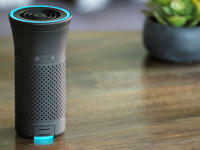Products are chosen independently by our editors. Purchases made through our links may earn us a commission.
In just the past few years, we've witnessed record-breaking wildfires cause catastrophic damage to land, property, and even life. Caused by factors like dry weather, hot temperatures, or strong winds, uncontrollable wildfires can burn millions of acres in an extremely fast and unpredictable manner.
When wildfires rage near your community, smoke and ash can affect you and your home, even if the fire isn't close enough to call for an evacuation. It can collect on any and every available surface including your car, home, driveway, yard, and patio. Smoke and ash can also build up inside your home, even when windows and doors are secured shut.
If there is an active fire threatening your home, you may need to evacuate. Once it is safe to return to your home or safe to go outside again, you’ll likely need to give your home and yard a deep clean. In the unfortunate case that a wildfire has caused extensive destruction to your house, it is best to talk with your insurance provider before making any clean-up decisions. But, if you can start cleaning safely, here’s what you need to know.
When to start the cleanup process
Once local authorities deem it safe for you to go out of doors (or return to your home if you had been evacuated), cleanup should start immediately.
Bud Summers, the executive vice president of operations and training at PuroClean, a property damage restoration service, says, “The sooner you can do it, the better.”
The longer you leave soot, ash, and other debris sitting, the more likely it’ll be difficult to clean off. Settled debris can also cause long-lasting damage to particular materials.
Summers explains, “Smoke can have an acidic residue, and if it sits too long, it can etch metal.”
Porous materials, like some plastics, can also suffer damage from ash, and if it’s left stagnant for too long, it becomes nearly impossible to clean, which means you’ll have to dispose of those items.
What to wear for protection
Before beginning a clean-up project, you need to consider your health and safety. In other words, be prepared with the proper personal protective equipment.
Without it, cleaning up ash and soot from a wildfire event can be hazardous. Ash contains both large and small particles of dust, dirt, and soot. It is extremely irritating to the skin and lungs when inhaled, according to the Environmental Protection Agency (EPA). When you’re cleaning up, ash particles can easily be swept up into the air, making them easy to accidentally inhale.
When it comes to protective gear, you should wear work gloves and heavy-soled shoes, as recommended by The American Red Cross. The EPA suggests protective goggles or glasses, along with an N95 respirator mask marked with “NIOSH” and either “N95” or “P100,” at a minimum. This means the mask has been tested and approved by the National Institute for Occupational Safety and Health. It will protect you from inhaling smoke, ash, or toxic substances that could be mixed in with the debris.
- Get the 3M Particulate Respirator 8210 N95 (Pack of 20) from Amazon for $26
- Get Honeywell P100 Deluxe Disposable Respirator at The Home Depot for $10.98 (Available in-store only)
In the event that you don't have access to an N95 respirator, the San Francisco Department of Public Health recommends using a surgical mask or a multi-layered cloth face covering. The cloth covering should be thick enough to not see light shine through when held up to a light.
How to clean the exterior of your house
Your home structure is likely the largest item you’ll need to tackle.
Start by cleaning away ash that may cover your exterior walls or siding. Summers recommends using a pressure washer to safely remove any stubborn soot or debris.
If you don’t have a pressure washer on hand, you can buy a pressure nozzle to attach to a garden hose, and that should work just as well.
For windows and windows sills, you can start by using a gentle dish soap, like Dawn and water mixture. Use a microfiber towel to clean effectively, and make sure you carefully separate clean towels from the dirty ones you’ve already used in order to avoid continuously rubbing around ash and soot.
“One of the best cleaning tips for homeowners is to have two buckets of water: One that you can put clean towels into, and [another for] those towels get dirty and saturated with soot,” says Summers. “If you take a dirty towel and put it in the [clean] bucket, you’ve contaminated your cleaning solution, and it may smear the soot.”
What to do when the interior of your home needs cleaning
Believe it or not, wildfire smoke can enter your home in several ways—even if your windows or doors are kept shut. Smoke can seep in through ventilation systems like bathroom and kitchen fans, certain heating and HVAC systems, and even small openings and cracks around closed windows and doors.
If you find ash inside your home, use a mist bottle to lightly wet the ash and dust so that it won’t recirculate in the air while you clean. You can use a damp cloth or a mop, transferring this into a dirty bucket when the cloth or mop becomes saturated.
The EPA states that you can vacuum your home, as long as your vacuum uses a high-efficiency particulate air (HEPA) filter. The Dyson Ball Multi Floor Origin vacuum cleaner features whole-machine HEPA filtration and is certified by the Asthma and Allergy Foundation of America. If you don’t own one, you can also rent HEPA vacuum cleaners or buy HEPA filters made for your specific vacuum model.
Throughout the cleaning process, you should dispose of loose ash and debris in a wastebasket, while any dirty towels or cloths can be washed in a washing machine on high heat, says Summers.
Make sure to double-check your home’s HVAC filters, especially if your system was still running while the smoke passed through your area. If your air ducts seem clogged, it could mean your system is recirculating debris through your home. In this case, the EPA suggests having your ducts cleaned professionally.
Even after cleaning up your home, the smell of wildfire smoke may linger. You can address this by opening up windows (once the air quality outside is at a safe and healthy level) to air out the space. Try using box fans propped by your windows to help push out the smokey air.

Air purifiers work to reduce or remove pollutants from the air and have been proven to decrease the side effects of inhaling unhealthy air.
An air purifier can help eliminate that smoky smell by removing smoke particles from the air inside your home. We tested 20 different air purifiers and ranked the Winix 5500-2 as the best overall air purifier. It literally passed our smell test and noticeably removed cigarette smoke odor from our testing area.
Furniture like couches, carpets, and curtains may have to be dealt with on a case-by-case basis. However, just as you would with stinky shoes, you can sprinkle baking soda on certain soft materials to help deodorize the fabric.
How to clean your patio and your pool
Similar to the way you clean exterior walls, you can carefully use a power washer or hose to attack the settled-on soot. However, the EPA says to avoid letting the ash water mixture spill into any storm drains.
Once you’ve loosened up the ash with water, use a broom to sweep it up and dispose of it in the trash.
For cleaning your pool, the City of Malibu recommends to first use a pool skimmer to pick up any pollutants resting on the water’s surface. Then, use a pool brush to scrub the pool’s walls and ladders to remove stubborn soot or dirt.
From there, you should backwash your pool, which flushes out any debris that has built up in the pool filter. To do so, move your pool’s filter setting to “backwash” and let dirty water run out of a waste hose into a gravel lot or lawn area. Just make sure you don’t backwash your pool water into any storm drains. It’s not safe, and it’s often illegal.
You may need to repeat the pool skimming and backwashing process a few times to get your pool completely clean and filtered. Follow your state or county’s guidelines for specific details on how to care for your pool.
How to clean your yard and vegetation
If your bushes, flowers, and trees are covered with ash, grab a hose and spray down the plants with clean water.
Do not use a leaf blower, because doing so will sweep residual ash into the air, making particles easy to inhale and will result in even more cleanup later.
Summers says that spraying down plants will properly clean them off and provide them with any water they may need after a wildfire event. Some plants may be past saving, unfortunately.
When you’d rather not DIY
If you’re not comfortable with cleaning up on your own, or you feel that you may inadvertently damage certain furniture or materials in your home or yard, Summers recommends consulting an expert.
For example, he says, “If you try to clean walls with soot on it, and it isn’t done properly, everything will have to be repainted.”
Regarding any part of the cleanup process, don’t hesitate to seek out local updates and resources from your county or state, as this can help keep you safe and informed as you work towards recovery.


